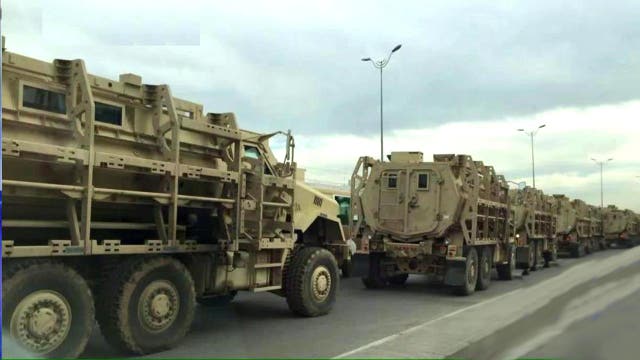Dozens of MRAPs provided by the U.S. government to its Kurdish allies in Iraq have arrived without protective side armor, Fox News has learned, with one security contractor who works with the Kurds saying the missing armor makes riding in them tantamount to "committing suicide."
The U.S. government promised 250 Mine-Resistant Ambush Protected Vehicles (MRAPs) for Iraqi allies to help in the fight against the Islamic State.
But Phil Hudicourt, former Army Special Forces member who has spent more than a decade in Iraq, told Fox News the vehicles are "dangerous" without the armor plates.
"The military calls it an 'RPG magnet'," he said. "I don't know what level it was made, if it was made at a low level, high level, but it's a pretty stupid decision. Because riding in those MRAPs with all the amount of RPG 29s in the country is committing suicide."
Fox News reviewed photos of about 30 MRAPs that arrived in Erbil, northern Iraq, last month. The photos appear to show empty side racks when compared with fully equipped models.
The large armor plates in question were added to MRAPs during the second Iraq war, when U.S. commanders on the ground realized that -- while the vehicles could protect against IEDs and land mines because of their reinforced base -- they were vulnerable to rocket-propelled grenade attacks from the side.
"So the difference is whether you survive the hit or don't survive the hit," said Steve Bucci, former special forces and senior Pentagon official during the Bush administration.
"Without the plates, the RPG is specially designed to attack armored vehicles. When it hits the vehicle, it literally punches a hole inside it, right through the armor and then throws a lot of hot metal around inside the vehicle so it's designed to kill anybody inside and if possible cause the vehicle to explode," said Bucci, now director of the Allison Center for Foreign Policy Studies at The Heritage Foundation.
Hudicourt said the Kurds believe the U.S. government is concerned the armor plate technology could fall into Iranian hands, a point that was not disputed by U.S. officials in Washington, D.C.
But ISIS has now overrun Syrian armories, and has the Russian-made RPG 29 which can slice through an MRAP, killing all on board.
"The RPG29 is a tandem rocket, dual warhead rocket, and without the plates, can go through the side of an MRAP like it was a sardine can," Hudicourt explained, adding U.S. special forces in northern Iraq working with the Kurds are not willing to ride inside the vehicles because the risk is high.
"Initially we thought that Baghdad [the Iraqi government] was doing something, doing some shenanigans because there's no plates on those vehicles," Hudicourt said, explaining there was initial suspicion the Shia-led government was stripping off the plates. But, he said, "We call friends of ours in the South and apparently the ones in the South are the same way, there's no sideplates on the cars, on the vans. And they're basically a very expensive bulletproof vehicle."
Over a four-day period, the State and Defense Departments investigated the photos provided by Fox News, as well as the Kurdish claims. A State Department official confirmed the MRAPs were sent as part of a used equipment program known as "Excess Defense Articles," or EDA.
The same State Department official said the side armor is considered an "upgrade" and not standard issue on the vehicle. Further, the official said the technology is not available to any U.S. allies.
The statement given to Fox News reads in part:
"The State Department reviews each EDA request on a case-by-case basis that considers the needs of potential recipients, safeguarding potentially sensitive defense technologies, as well as the ability of the recipient to operate and sustain the equipment, among other factors. Under U.S. policy, Anti-EFP (Explosive Formed Penetrator), or any other types of vehicle Side-Armor, are not part of the MRAPs standard configuration and is not exportable. Partners do have the option to install their own or purchase comparable systems elsewhere."
The official emphasized the vehicles still offer strong protection against IEDs and land mines, adding the Iraqi government paid to ship and refurbish the vehicles, with a used value of $73,300. A comparable, new MRAP runs about $400,000.
Bucci, who has worked with the EDA program, said the U.S. government may not have a legal responsibility, but has a "moral" obligation to help the Kurds upgrade the vehicles or provide technicians who can advise them.
"If we can't give them the high-tech plates, then give them something else that is going to make those vehicles usable and safe, so that the risk they take is reasonable as they go into combat, essentially, for us," Bucci said. "Sending them vehicles that are not up to par, that are not gonna protect them in the way that they are intended is foolishness, and even if it wasn't the intent, that message that America really doesn't care that much is what's gonna be read into this."





